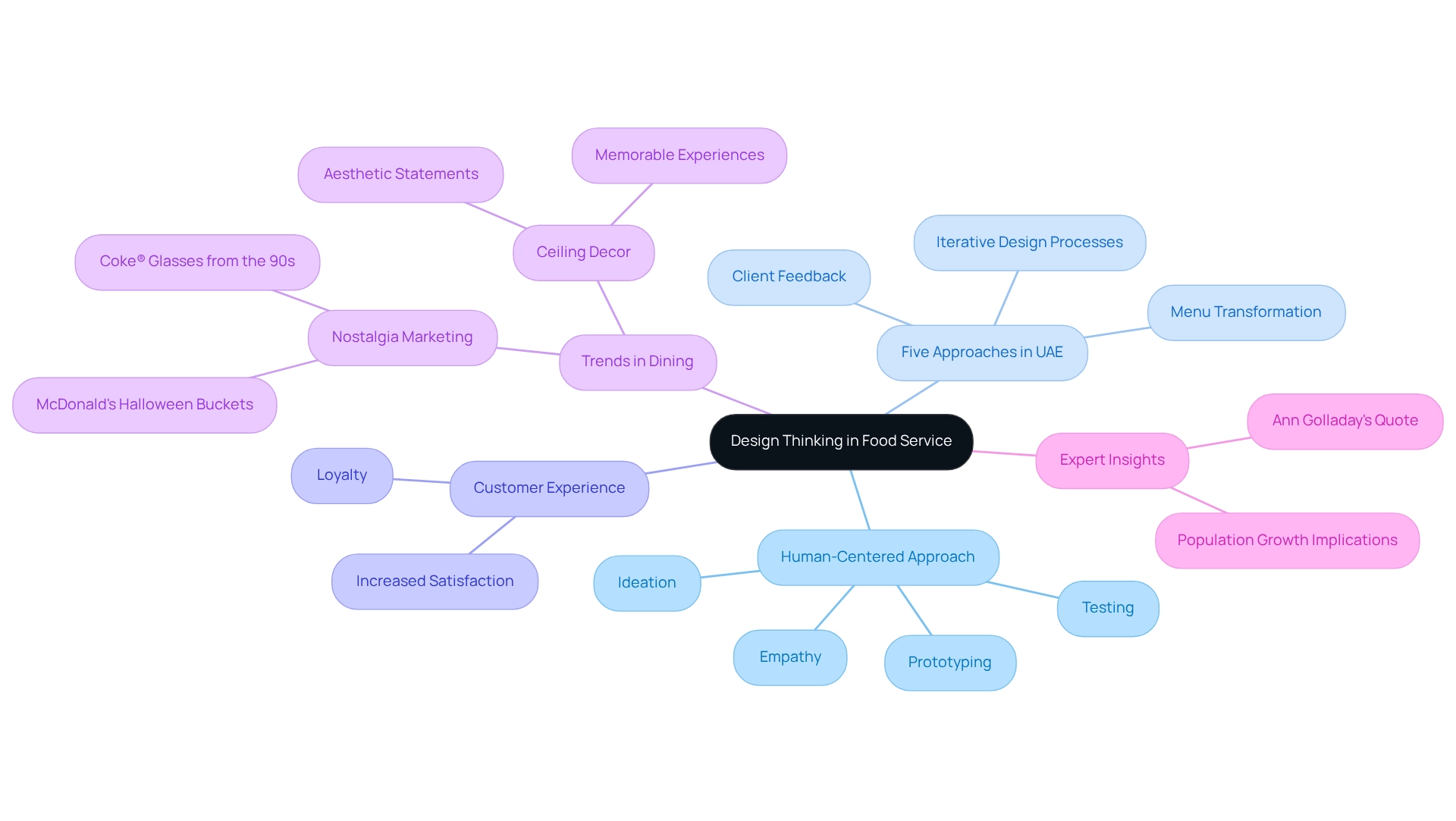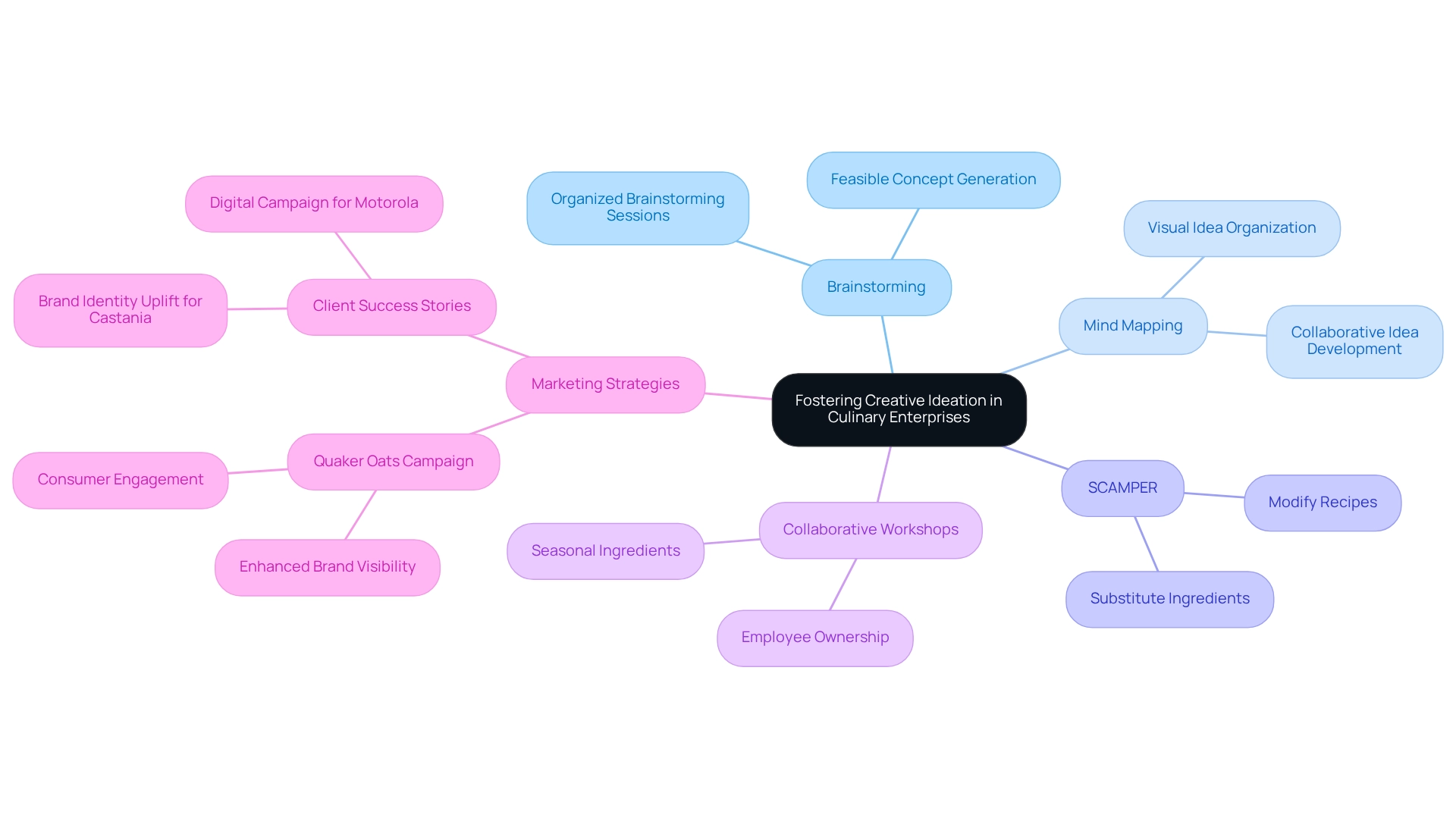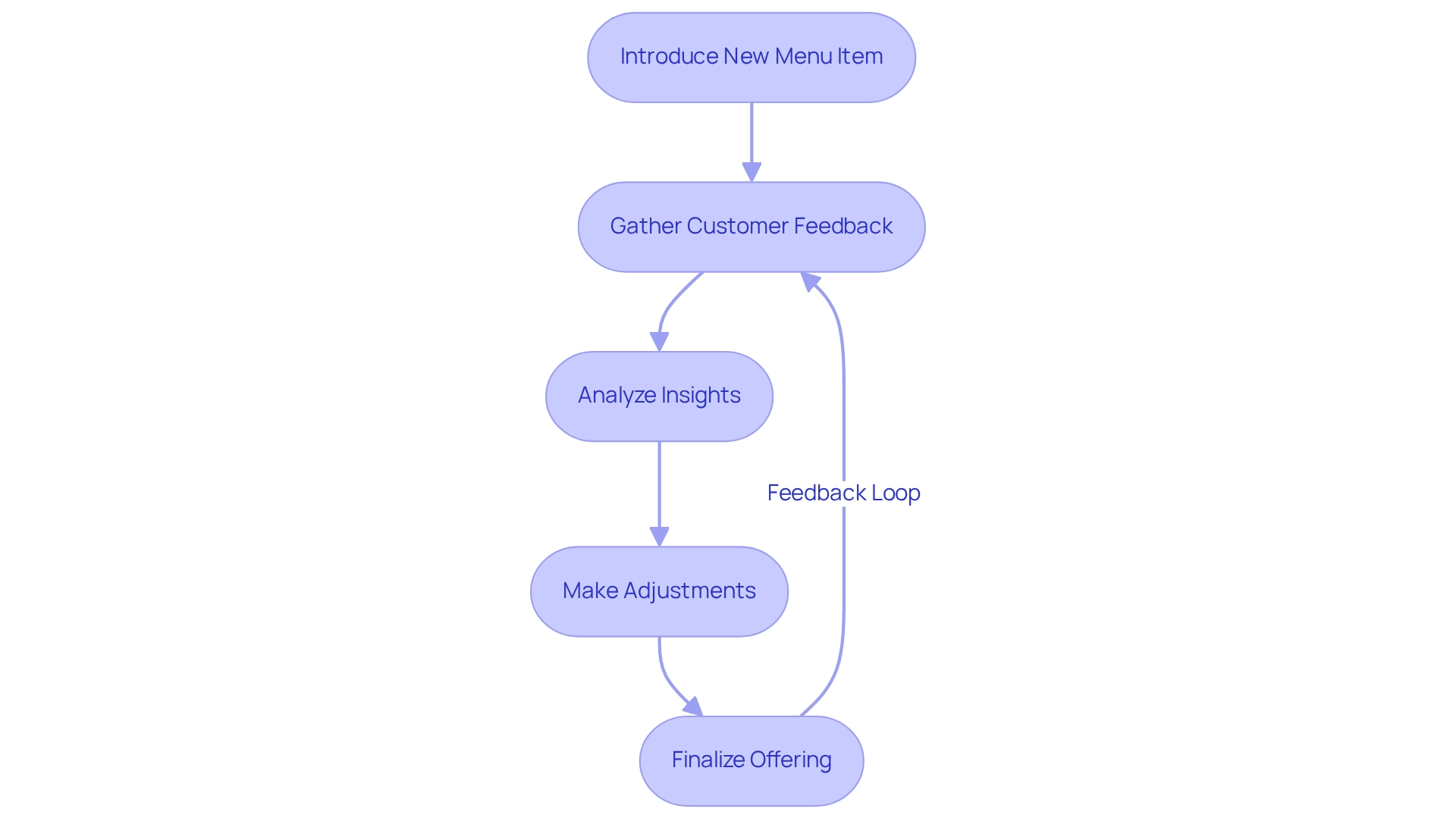General
5 Design Thinking Approaches for Food Service Businesses in the UAE
Overview
This article presents five design thinking approaches that food service businesses in the UAE can implement to significantly enhance customer experience and operational efficiency:
- Prioritizing customer empathy
- Fostering creative ideation
- Employing rapid prototyping
- Integrating feedback
- Adopting sustainable practices
These methodologies empower restaurants to align their offerings with consumer preferences. Ultimately, this alignment leads to heightened satisfaction and loyalty among patrons, establishing a competitive edge in the market.
Introduction
In a landscape where culinary experiences transcend mere meals, the food service industry is witnessing a transformative shift propelled by design thinking. This innovative approach prioritizes the needs and desires of diners, fundamentally reshaping aspects from menu development to customer interactions.
As businesses endeavor to craft memorable dining experiences, trends such as immersive decor and nostalgia-driven marketing emerge as pivotal elements in securing customer loyalty.
With an emphasis on empathy, ideation, and rapid prototyping, food service establishments are not merely responding to consumer preferences; they are actively engaging them in the creation process.
By embracing these principles, restaurants can adeptly navigate the complexities of a competitive market, ensuring they not only meet but exceed customer expectations.
Understanding Design Thinking in Food Service
Design thinking represents a human-centered approach to innovation that prioritizes understanding the needs and experiences of users. In the dining sector, the implementation of five design thinking approaches for food service businesses in the UAE is transforming how companies create menus, design environments, and establish client interactions. By emphasizing empathy, ideation, prototyping, and testing, dining establishments can align their offerings more closely with client expectations, leading to increased satisfaction and loyalty.
Recent trends in design thinking for the dining sector in 2025 highlight a growing focus on creating immersive dining experiences that resonate with clients. For instance, innovative ceiling decor is becoming a focal point in restaurant design, allowing businesses to make bold aesthetic statements that enhance the overall ambiance. This trend not only fascinates patrons but also contributes to a memorable dining experience, as recent studies indicate that ceiling decor is becoming essential to commercial design.
Moreover, the adoption of five design thinking approaches for food service businesses in the UAE is supported by statistics indicating a significant shift towards user-focused design. For example, McDonald’s is re-releasing their Halloween buckets and Coke® glasses from the 90s, illustrating a trend in nostalgia marketing that resonates with consumers. Restaurants employing five design thinking approaches for food service businesses in the UAE report higher patron satisfaction rates, as they are better equipped to address consumer preferences and pain points.
Effective case studies, such as those highlighting the transformation of menu options through client feedback and iterative design processes, demonstrate the concrete advantages of this method.
Expert insights emphasize the significance of design thinking in promoting innovation within the dining industry. Ann Golladay, Senior Director, asserts that overall population figures will continue to increase, which has profound implications for the catering sector. By stepping into the shoes of their clients, businesses can cultivate a deeper understanding of their audience, which is crucial in a competitive market like the UAE.
This approach not only enhances the client experience but also boosts business outcomes, making the five design thinking approaches for food service businesses in the UAE a vital strategy for culinary enterprises aiming to thrive in today’s dynamic environment.
Additionally, dedicated research analyst support and report format modifications are available for clients seeking to adopt design thinking, offering a comprehensive perspective on the assistance available for businesses navigating this evolving sector.

Emphasizing Customer Empathy
Customer empathy stands as a pivotal component among the five design thinking approaches tailored for food service businesses in the UAE. It necessitates an active engagement in listening to and comprehending the needs, desires, and challenges of patrons. To effectively gather client insights, eateries can employ a diverse array of methods, including:
- Surveys
- Focus groups
- Direct interviews
For example, a restaurant may closely observe patron interactions to pinpoint specific pain points in the dining experience, such as prolonged wait times or confusion regarding menu items.
Addressing these concerns enables businesses to leverage the five design thinking approaches for food service in the UAE, allowing them to tailor their services to align more closely with client expectations. This alignment is crucial as it leads to enhanced satisfaction and increased repeat visits.
This compassionate approach not only elevates the dining experience but also cultivates a loyal clientele. Statistics reveal that establishments prioritizing guest satisfaction through empathy experience a notable increase in repeat patronage. Research indicates that 70% of diners are more inclined to return to venues that actively seek and respond to their feedback. As Dheeraj Gowrie, an Executive at Frogfoot Networks, aptly articulates, “Customers don’t just want to be heard, they want control.”
This statement underscores the importance of empowering clients through robust feedback systems.
Furthermore, expert perspectives suggest that fostering a culture of compassion within the dining sector can effectively integrate the five design thinking approaches for food service businesses in the UAE. This integration yields innovative solutions that resonate with patrons and drive business success in a competitive landscape. Case studies illustrate that restaurants implementing customer feedback systems have significantly improved quality and overall client experience, reinforcing the critical role of empathy in the dining industry.

Fostering Creative Ideation
Fostering an environment of imaginative thinking is crucial for culinary enterprises aiming to innovate and maintain competitiveness, particularly through the application of five design thinking approaches for food service businesses in the UAE. Encouraging team members to brainstorm freely—without the fear of judgment—can lead to a wealth of innovative ideas. Methods such as brainstorming sessions, mind mapping, and the SCAMPER technique serve as valuable instruments in applying the five design thinking approaches for food service businesses in the UAE, generating innovative ideas related to menu items, enhancements in offerings, or marketing strategies.
For instance, a café might host a creative workshop where employees collaborate to develop new beverage recipes inspired by seasonal ingredients. This initiative not only ignites creativity but also fosters a sense of ownership among employees, making them feel valued and integral to the business’s success.
Furthermore, studies indicate that organized brainstorming can significantly enhance creativity within the culinary industry, with data revealing that groups employing these methods frequently generate more feasible concepts than those that do not. The DIVINFOOD initiative exemplifies co-creation in action, focusing on agrobiodiversity-rich value chains through Living Labs, which underscores the collaborative essence of creative ideation in culinary enterprises.
Moreover, the extensive campaign for Quaker Oats, crafted by WonderEight, serves as a compelling case study demonstrating how effective marketing strategies can elevate brand visibility and consumer engagement. By emphasizing innovative thinking, restaurants can leverage the five design thinking approaches for food service businesses in the UAE to effectively adapt their menus and offerings in alignment with evolving consumer preferences, ultimately enhancing customer satisfaction and loyalty. Client success stories, such as the brand identity uplift for Castania and the digital campaign for Motorola, further reinforce the significance of creativity in achieving measurable outcomes within the industry.
WonderEight’s innovative branding and digital marketing solutions play a pivotal role in assisting culinary enterprises to harness creative ideation, thereby enhancing their market presence and fostering connections with consumers.

Rapid Prototyping for Effective Solutions
Rapid prototyping stands as a pivotal strategy among the five design thinking approaches for food service businesses in the UAE, enabling the swift and cost-effective creation of new menu items or service concepts. This method allows establishments to introduce limited-time meals, effectively gauging diner reactions and gathering valuable insights prior to finalizing their offerings. For example, a restaurant may unveil a seasonal dish, monitor customer feedback, and make necessary adjustments based on insights acquired during this trial phase.
This iterative process not only refines menu items but also ensures alignment with customer preferences and quality standards. By embracing the five design thinking approaches for food service businesses in the UAE, culinary enterprises can innovate with enhanced confidence, significantly mitigating the risk of costly errors. As we approach 2025, the advantages of rapid prototyping are increasingly evident, given the fast-paced nature of the industry that necessitates agility and responsiveness to consumer trends.
Statistics reveal that restaurants utilizing rapid prototyping can boost their menu development efficiency by up to 30%, allowing them to remain competitive in a saturated market. Furthermore, with over 250 knowledge base articles available, food service enterprises have access to a wealth of information that can support their prototyping endeavors.
Successful case studies, such as a fast-food chain that calculated its daily overhead rate at $451.61 to enhance financial planning, demonstrate how effective prototyping can lead to improved resource management and increased patron satisfaction. Additionally, the influence of limited-time offers on client feedback is significant; they not only instill a sense of urgency but also yield critical insights into consumer preferences. Expert insights suggest that testing new menu items through rapid prototyping can foster a more engaged clientele and enhance retention rates.
Moreover, the importance of multilingual support in restaurant applications cannot be overlooked, as it is essential for effective communication with diverse client groups. In summary, the integration of rapid prototyping within the culinary industry, particularly through the five design thinking approaches for food service businesses in the UAE, represents a transformative strategy that promotes innovation and elevates the overall dining experience.

Testing and Iterating Based on Feedback
Integrating client feedback into the five design thinking approaches for food service businesses in the UAE is essential for those aiming to thrive in a competitive landscape. Establishing effective methods for collecting feedback—such as comment cards, online surveys, and social media interactions—enables eateries to gain invaluable insights directly from their customers. Analyzing this feedback uncovers trends and identifies areas for improvement.
For instance, if a significant number of patrons express that a specific dish is excessively spicy, the establishment can modify the recipe to better align with customer preferences.
This iterative process not only enhances client satisfaction but also underscores a restaurant’s commitment to addressing consumer needs. Such responsiveness cultivates loyalty and encourages positive word-of-mouth, which is critical in the food service industry. In 2025, the importance of client feedback systems cannot be overstated; only about 4% of clients who threaten to leave are persuaded to stay by promotional offers, a sharp decline from the previous average of 20%.
This statistic highlights the necessity for dining establishments to prioritize authentic interaction and continuous improvement based on client feedback.
As Betsy Sanders aptly states, “Service, in short, is not what you do, but who you are,” reinforcing the notion that client feedback reflects the establishment’s identity and dedication to service. Successful case studies, such as the redesign of Pierpont’s website, exemplify the effectiveness of testing and iterating based on client feedback. By performing a competitive analysis, Pierpont’s was able to refine its online presence, enhancing user engagement and effectively promoting special offerings.
This commitment to adapting according to client feedback not only positions restaurants as leaders in their field but also ensures they remain relevant and appealing by implementing the five design thinking approaches for food service businesses in the UAE. Furthermore, client success stories, including the brand identity uplift for Castania and the digital campaign for Motorola, demonstrate measurable outcomes from effective branding strategies, further emphasizing the significance of integrating customer feedback into the design process.
Implementing Sustainable Design Thinking Strategies
Incorporating five design thinking approaches for food service businesses in the UAE into culinary service operations is essential for promoting eco-friendly practices that resonate with today’s consumers. This strategy includes various initiatives, such as:
- Sourcing local ingredients
- Minimizing food waste
- Utilizing sustainable packaging solutions
For instance, adopting a farm-to-table model enables eateries to showcase local produce, thereby reducing their carbon footprint and bolstering local economies.
Research indicates that eateries can considerably diminish their environmental impact by prioritizing locally sourced ingredients, which not only reduces transportation emissions but also enhances the freshness of menu offerings. Furthermore, a 2019 survey revealed that nearly two-thirds of Generation Z consumers are prepared to invest more in sustainable products, underscoring the growing demand for eco-friendly options in the marketplace.
Understanding waste in the culinary sector is crucial for restaurants, as it represents both a business and social concern. By embracing sustainability, food service businesses can effectively attract environmentally conscious patrons through the implementation of five design thinking approaches for food service businesses in the UAE, positioning themselves as leaders in responsible dining. This commitment not only elevates brand image but also cultivates customer loyalty, as consumers increasingly favor establishments that align with their values.
As the cost of living crisis escalates globally, consumers have significantly modified their spending behaviors, with the majority (53%) of global consumers ‘holding back’ on non-essential expenditures. This shift further emphasizes the necessity for restaurants to adapt to these evolving preferences.
Implementing practices such as:
- Streamlining ingredient orders
- Enhancing kitchen preparation
- Conducting regular quality checks and consumer feedback
can further reduce waste and improve operational efficiency. Ultimately, the application of the five design thinking approaches for food service businesses in the UAE contributes to a more sustainable future in the food service industry.
Conclusion
The integration of design thinking within the food service industry signifies a pivotal evolution in how restaurants engage with their customers. By prioritizing empathy, businesses gain a deeper understanding of diners’ needs, fostering loyalty and enhancing the overall dining experience. The focus on creative ideation and rapid prototyping empowers establishments to innovate and adapt swiftly to shifting consumer preferences, ensuring that menus and services resonate profoundly with patrons.
Furthermore, the significance of testing and iterating based on customer feedback is paramount. Actively soliciting and acting upon customer insights enables restaurants to refine their offerings, showcasing a genuine commitment to service. This approach not only elevates customer satisfaction but also cultivates a robust brand identity that aligns seamlessly with consumer values.
Sustainability emerges as another critical element within this transformative landscape. As diners increasingly seek eco-friendly options, restaurants that adopt sustainable design thinking strategies can effectively attract conscientious consumers while mitigating their environmental impact. By sourcing local ingredients and minimizing waste, food service businesses position themselves as leaders in responsible dining.
In conclusion, the fusion of design thinking principles in the food service industry transcends mere trend; it represents a fundamental shift toward creating meaningful and memorable dining experiences. By embracing these strategies, restaurants can adeptly navigate the complexities of a competitive market, ensuring they not only meet but exceed customer expectations while fostering loyalty and sustainability for the future.
Frequently Asked Questions
What is design thinking in the context of the dining sector?
Design thinking represents a human-centered approach to innovation that focuses on understanding the needs and experiences of users, specifically in food service businesses.
How is design thinking being implemented in food service businesses in the UAE?
Food service businesses in the UAE are implementing five design thinking approaches to transform menu creation, environment design, and client interactions, aligning offerings more closely with client expectations.
What are some recent trends in design thinking for the dining sector?
Recent trends include a focus on creating immersive dining experiences, with elements like innovative ceiling decor becoming essential to commercial design, enhancing ambiance and overall dining experiences.
What are the benefits of adopting design thinking approaches in restaurants?
Restaurants that adopt design thinking approaches report higher patron satisfaction rates as they can better address consumer preferences and pain points, leading to increased customer loyalty.
What role does customer empathy play in design thinking for food service?
Customer empathy is crucial as it involves actively listening to and understanding the needs and challenges of patrons, which helps businesses tailor their services to enhance satisfaction and repeat visits.
How can restaurants gather client insights to improve their services?
Restaurants can gather client insights through methods such as surveys, focus groups, and direct interviews, enabling them to identify and address specific pain points in the dining experience.
What impact does prioritizing guest satisfaction through empathy have on repeat patronage?
Establishments that prioritize guest satisfaction through empathy experience a notable increase in repeat patronage, with research indicating that 70% of diners are more likely to return to venues that actively seek and respond to their feedback.
How can fostering a culture of compassion benefit dining establishments?
Fostering a culture of compassion can help integrate design thinking approaches, yielding innovative solutions that resonate with patrons and drive business success in a competitive landscape.
What support is available for businesses looking to adopt design thinking?
Dedicated research analyst support and report format modifications are available for clients seeking to adopt design thinking, providing comprehensive perspectives on navigating the evolving dining sector.



